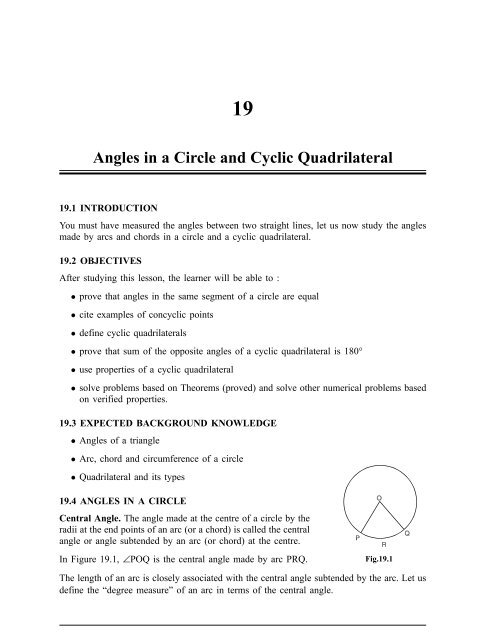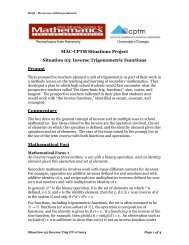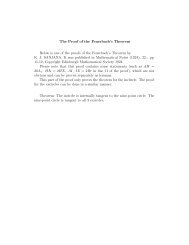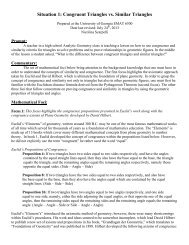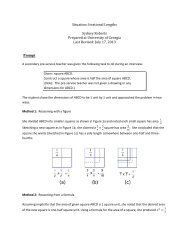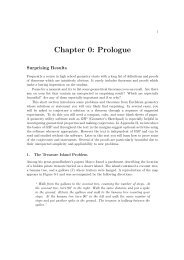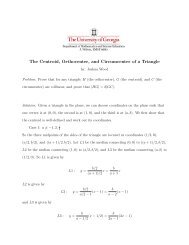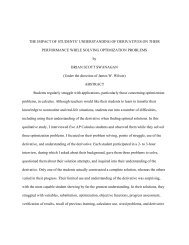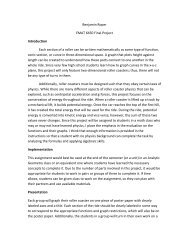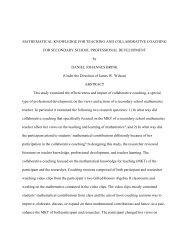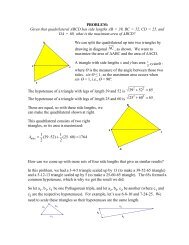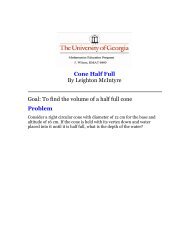Angles in a Circle and Cyclic Quadrilateral
Angles in a Circle and Cyclic Quadrilateral
Angles in a Circle and Cyclic Quadrilateral
You also want an ePaper? Increase the reach of your titles
YUMPU automatically turns print PDFs into web optimized ePapers that Google loves.
130 Mathematics<br />
19<br />
<strong>Angles</strong> <strong>in</strong> a <strong>Circle</strong> <strong>and</strong> <strong>Cyclic</strong> <strong>Quadrilateral</strong><br />
19.1 INTRODUCTION<br />
You must have measured the angles between two straight l<strong>in</strong>es, let us now study the angles<br />
made by arcs <strong>and</strong> chords <strong>in</strong> a circle <strong>and</strong> a cyclic quadrilateral.<br />
19.2 OBJECTIVES<br />
After study<strong>in</strong>g this lesson, the learner will be able to :<br />
• prove that angles <strong>in</strong> the same segment of a circle are equal<br />
• cite examples of concyclic po<strong>in</strong>ts<br />
• def<strong>in</strong>e cyclic quadrilaterals<br />
• prove that sum of the opposite angles of a cyclic quadrilateral is 180°<br />
• use properties of a cyclic quadrilateral<br />
• solve problems based on Theorems (proved) <strong>and</strong> solve other numerical problems based<br />
on verified properties.<br />
19.3 EXPECTED BACKGROUND KNOWLEDGE<br />
• <strong>Angles</strong> of a triangle<br />
• Arc, chord <strong>and</strong> circumference of a circle<br />
• <strong>Quadrilateral</strong> <strong>and</strong> its types<br />
19.4 ANGLES IN A CIRCLE<br />
Central Angle. The angle made at the centre of a circle by the<br />
radii at the end po<strong>in</strong>ts of an arc (or a chord) is called the central<br />
angle or angle subtended by an arc (or chord) at the centre.<br />
In Figure 19.1, ∠POQ is the central angle made by arc PRQ.<br />
Fig.19.1<br />
The length of an arc is closely associated with the central angle subtended by the arc. Let us<br />
def<strong>in</strong>e the “degree measure” of an arc <strong>in</strong> terms of the central angle.
<strong>Angles</strong> <strong>in</strong> a <strong>Circle</strong> <strong>and</strong> <strong>Cyclic</strong> <strong>Quadrilateral</strong> 131<br />
The degree measure of a m<strong>in</strong>or arc of a circle is the measure of<br />
its correspond<strong>in</strong>g central angle.<br />
In Figure 19.2, Degree measure of PQR = x°<br />
The degree measure of a semicircle <strong>in</strong> 180° <strong>and</strong> that of a major<br />
arc is 360° m<strong>in</strong>us the degree measure of the correspond<strong>in</strong>g m<strong>in</strong>or<br />
arc.<br />
Relationship between length of an arc <strong>and</strong> its degree measure.<br />
Fig.19.2<br />
Length of an arc = circumference<br />
degree measure of the arc<br />
×<br />
360°<br />
If the degree measure of an arc is 40°<br />
then length of the arc PQR = 2πr.<br />
40°<br />
2<br />
πr<br />
360° = 9<br />
Inscribed angle : The angle subtended by an arc (or chord) on<br />
any po<strong>in</strong>t on the rema<strong>in</strong><strong>in</strong>g part of the circle is called an <strong>in</strong>scribed<br />
angle.<br />
In Figure 19.3, ∠PAQ is the angle <strong>in</strong>scribed by arc PRQ at po<strong>in</strong>t<br />
A of the rema<strong>in</strong><strong>in</strong>g part of the circle or by the chord PQ at the<br />
po<strong>in</strong>t A.<br />
19.5. SOME IMPORTANT PROPERTIES<br />
ACTIVITY FOR YOU :<br />
Fig.19.3<br />
Draw a circle with centre O. Let PAQ be an arc <strong>and</strong> B any po<strong>in</strong>t<br />
on the circle.<br />
Measure the central angle POQ <strong>and</strong> an <strong>in</strong>scribed angle PBQ by<br />
the arc at rema<strong>in</strong><strong>in</strong>g part of the circle. We observe that<br />
∠POQ = 2∠PBQ<br />
Repeat this activity tak<strong>in</strong>g different circles <strong>and</strong> different arcs. We<br />
observe that<br />
Fig.19.4<br />
The angle subtended at the centre of a circle by an arc<br />
is double the angle subtended by it on any po<strong>in</strong>t on the<br />
rema<strong>in</strong><strong>in</strong>g part of the circle.<br />
Let O be the centre of a circle. Consider a semicircle PAQ <strong>and</strong><br />
its <strong>in</strong>scribed angle PBQ<br />
∴<br />
2 ∠PBQ = ∠POQ<br />
Fig.19.5
132 Mathematics<br />
(S<strong>in</strong>ce the angle subtended by an arc at the centre is double the angle subtended by it at any<br />
po<strong>in</strong>t on the rema<strong>in</strong><strong>in</strong>g part of the circle)<br />
But ∠POQ = 180° (S<strong>in</strong>ce PQ is a diameter of the circle)<br />
2∠PBQ = 180°<br />
∴ ∠PBQ = 90°<br />
Thus, we conclude the follow<strong>in</strong>g :<br />
Angle <strong>in</strong> a semicircle is a right angle.<br />
Theorem : <strong>Angles</strong> <strong>in</strong> the same segment of a circle are equal.<br />
Given : A circle with centre O <strong>and</strong> the angles ∠PRQ <strong>and</strong> ∠PSQ <strong>in</strong> the same segment formed<br />
by the chord PQ (or arc PAQ)<br />
To prove : ∠PRQ = ∠PSQ<br />
Construction : Jo<strong>in</strong> OP <strong>and</strong> OQ.<br />
Proof : As the angle subtended by an arc at the centre is double<br />
the angle subtended by it at any po<strong>in</strong>t on the rema<strong>in</strong><strong>in</strong>g part of<br />
the circle, therefore we have<br />
∠POQ = 2 ∠PRQ<br />
...(i)<br />
<strong>and</strong> ∠POQ = 2∠PSQ ...(ii)<br />
From (i) <strong>and</strong> (ii), we get<br />
Fig.19.6<br />
2∠PRQ = 2∠PSQ<br />
∴ ∠PRQ = ∠PSQ<br />
We take some examples us<strong>in</strong>g the above results<br />
Example 19.1 : In Figure 19.7, O is the centre of the circle <strong>and</strong><br />
∠AOC = 120°. F<strong>in</strong>d ∠ABC.<br />
Solution : It is obvious that ∠x is the central angle subtended<br />
by the arc APC <strong>and</strong> ∠ABC is the <strong>in</strong>scribed angle.<br />
∴ ∠x=2∠ABC<br />
But ∠x = 360° – 120°<br />
∴ 2∠ABC = 240°<br />
Fig.19.7<br />
∴ ∠ABC = 120°<br />
Example 19.2 : In Figure 19.8 O is the centre of the circle <strong>and</strong> ∠PAQ = 35°. F<strong>in</strong>d ∠OPQ.<br />
Solution : ∠POQ = 2∠PAQ = 70° ...(i)<br />
(Angle at the centre is double the angle on the rema<strong>in</strong><strong>in</strong>g part of the circle)
<strong>Angles</strong> <strong>in</strong> a <strong>Circle</strong> <strong>and</strong> <strong>Cyclic</strong> <strong>Quadrilateral</strong> 133<br />
S<strong>in</strong>ce OP = OQ (Radii of the same circle)<br />
∴ ∠OPQ = ∠OQP ...(ii)<br />
(<strong>Angles</strong> opposite to equal sides are equal)<br />
But ∠OPQ + ∠OQP + ∠POQ = 180°<br />
∴ 2∠OPQ = 180° – 70° = 110°<br />
∴ ∠OPQ = 55°.<br />
Fig.19.8<br />
Example 19.3 : In Figure 19.9, O is the centre of the circle <strong>and</strong> AD bisects ∠BAC. F<strong>in</strong>d ∠BCD.<br />
Solution : S<strong>in</strong>ce BC is a diameter<br />
∠BAC = 90°<br />
(Angle <strong>in</strong> the semicircle is a right angle)<br />
As AD bisects ∠BAC<br />
∴ ∠BAD = 45°<br />
But ∠BCD = ∠BAD<br />
Fig.19.9<br />
(<strong>Angles</strong> <strong>in</strong> the same segment of a circle are equal)<br />
∴ ∠BCD = 45°.<br />
Example 19.4 : In Figure 19.10, O is the centre of the circle, ∠POQ = 70° <strong>and</strong> PS⊥<br />
OQ . F<strong>in</strong>d<br />
∠MQS.<br />
Solution :<br />
2∠PSQ = ∠POQ = 70°<br />
(Angle subtended at the centre of a circle is twice the angle<br />
subtended by it on the rema<strong>in</strong><strong>in</strong>g part of the circle)<br />
∴ ∠PSQ = 35°<br />
Fig.19.10<br />
S<strong>in</strong>ce ∠MSQ + ∠SMQ + ∠MQS = 180°<br />
(Sum of the angles of a triangle)<br />
∴ 35° + 90° + ∠MQS = 180°<br />
∴ ∠MQS = 180° – 125° = 55°.<br />
CHECK YOUR PROGRESS 19.1<br />
1. In Figure 19.11, ADB is an arc of a circle with centre O, if ∠ACB = 35°, f<strong>in</strong>d ∠AOB.<br />
Fig. 19.11
134 Mathematics<br />
2. In Figure 19.12, AOB is a diameter of a circle with centre O. Is ∠APB = ∠AQB = 90°<br />
Give reasons.<br />
Fig. 19.12<br />
3. In Figure 19.13, PQR is an arc of a circle with centre O. If ∠PTR = 35°, f<strong>in</strong>d ∠PSR.<br />
Fig. 19.13<br />
4. In Figure 19.14, O is the centre of a circle <strong>and</strong> ∠AOB = 60°. F<strong>in</strong>d ∠ADB.<br />
Fig. 19.14<br />
19.6 CONCYCLIC POINTS<br />
Def<strong>in</strong>ition : Po<strong>in</strong>ts which lie on a circle are called<br />
concyclic po<strong>in</strong>ts.<br />
Let us now f<strong>in</strong>d certa<strong>in</strong> conditions under which<br />
po<strong>in</strong>ts are concyclic.<br />
If you take a po<strong>in</strong>t P, you can draw not only one<br />
but many circles pass<strong>in</strong>g through it as <strong>in</strong><br />
Fig. 19.15.<br />
Fig.19.15<br />
Now take two po<strong>in</strong>ts P <strong>and</strong> Q on a sheet of a paper. You can draw as many circles as you<br />
wish, pass<strong>in</strong>g through the po<strong>in</strong>ts. (Fig. 19.16).
<strong>Angles</strong> <strong>in</strong> a <strong>Circle</strong> <strong>and</strong> <strong>Cyclic</strong> <strong>Quadrilateral</strong> 135<br />
Fig. 19.16<br />
Let us now take three po<strong>in</strong>ts P, Q <strong>and</strong> R which do not lie on the same straight l<strong>in</strong>e. In this<br />
case you can draw only one circle pass<strong>in</strong>g through these three non-col<strong>in</strong>ear po<strong>in</strong>ts<br />
(Figure 19.17).<br />
Fig. 19.17<br />
Further let us now take four po<strong>in</strong>ts P, Q, R, <strong>and</strong> S which do not lie on the same l<strong>in</strong>e. You will<br />
see that it is not always possible to draw a circle pass<strong>in</strong>g through four non-coll<strong>in</strong>ear po<strong>in</strong>ts.<br />
In Fig 19.18 (a) <strong>and</strong> (b) po<strong>in</strong>ts are noncyclic but concyclic <strong>in</strong> Fig 19.18(c).<br />
(a) (b) (b)<br />
Fig. 19.18<br />
Note. If the po<strong>in</strong>ts P, Q <strong>and</strong> R are coll<strong>in</strong>ear then it is not possible to draw a circle pass<strong>in</strong>g<br />
through them.<br />
Thus we conclude<br />
1. Given one or two po<strong>in</strong>ts there are <strong>in</strong>f<strong>in</strong>itely many circles pass<strong>in</strong>g through them.<br />
2. Three non-coll<strong>in</strong>ear po<strong>in</strong>ts are always concyclic <strong>and</strong> there is only one circle pass<strong>in</strong>g<br />
through all of them.<br />
3. Three coll<strong>in</strong>ear po<strong>in</strong>ts are not concyclic (or noncyclic).<br />
4. Four non-coll<strong>in</strong>ear po<strong>in</strong>ts may or may not be concyclic.
136 Mathematics<br />
19.6.1 CYCLIC QUADRILATERAL<br />
A quadrilateral is said to be a cyclic quadrilateral if there is a<br />
circle pass<strong>in</strong>g through all its four vertices.<br />
For example, Fig. 19.19 shows a cyclic quadrilateral PQRS.<br />
Theorem. Sum of the opposite angles of a cyclic quadrilateral is 180°.<br />
Fig.19.19<br />
Given : A cyclic quadrilateral ABCD<br />
To prove : ∠BAD + ∠BCD = ∠ABC + ∠ADC = 180°<br />
Construction : Draw AC <strong>and</strong> DB<br />
Proof : ∠ACB = ∠ADB<br />
<strong>and</strong> ∠BAC = ∠BDC<br />
[<strong>Angles</strong> <strong>in</strong> the same segment]<br />
∴ ∠ACB + ∠BAC = ∠ADB + ∠BDC = ∠ADC<br />
Add<strong>in</strong>g ∠ABC on both the sides, we get<br />
Fig.19.20<br />
∠ACB + ∠BAC + ∠ABC = ∠ADC + ∠ABC<br />
But ∠ACB + ∠BAC + ∠ABC = 180° [Sum of the angles of a triangle]<br />
∴ ∠ADC + ∠ABC = 180°<br />
∴ ∠BAD + ∠BCD = 360° – (∠ADC + ∠ABC) = 180°.<br />
Hence proved.<br />
Converse of this theorem is also true.<br />
If a pair of opposite angles of a quadrilateral is supplementary, then the quadrilateral is cyclic.<br />
Verification :<br />
Draw a quadrilateral PQRS<br />
S<strong>in</strong>ce <strong>in</strong> quadrilateral PQRS,<br />
∠P + ∠R = 180°<br />
<strong>and</strong> ∠S + ∠Q = 180°<br />
Fig.19.21<br />
Therefore draw a circle pass<strong>in</strong>g through the po<strong>in</strong>t P, Q <strong>and</strong> R <strong>and</strong> observe that it also passes<br />
through the po<strong>in</strong>t S. So we conclude that quadrilateral PQRS is a cyclic quadrilateral.<br />
We solve some examples us<strong>in</strong>g the above results.<br />
Example 19.5 : ABCD is a cyclic parallelogram. Show that it<br />
is a rectangle.<br />
Solution : ∠A + ∠C = 180°<br />
(ABCD is a cyclic quadrilateral)<br />
S<strong>in</strong>ce ∠A =∠C<br />
[Opposite angles of a parallelogram]<br />
Fig.19.22
<strong>Angles</strong> <strong>in</strong> a <strong>Circle</strong> <strong>and</strong> <strong>Cyclic</strong> <strong>Quadrilateral</strong> 137<br />
or ∠A + ∠A = 180°<br />
∴ 2∠A = 180°<br />
∴ ∠A = 90°<br />
Thus ABCD is a rectangle.<br />
Example 19.6 : A pair of opposite sides of a cyclic quadrilateral is equal. Prove that its<br />
diagonals are also equal (See Figure 19.23).<br />
Solution : Let ABCD be a cyclic quadrilateral <strong>and</strong> AB = CD.<br />
⇒ arc AB = arc CD (Correspond<strong>in</strong>g arcs)<br />
Add<strong>in</strong>g arc AD to both the sides;<br />
arc AB + arc AD = arc CD + arc AD<br />
∴<br />
⇒<br />
arc BAD = arc CDA<br />
Chord BD = Chord CA<br />
⇒<br />
BD = CA<br />
Fig.19.23<br />
Example 19.7 : In Figure 19.24, PQRS is a cyclic quadrilateral whose diagonals <strong>in</strong>tersect at<br />
A. If ∠SQR = 80° <strong>and</strong> ∠QPR = 30°, f<strong>in</strong>d ∠SRQ.<br />
Solution : Given ∠SQR = 80°<br />
S<strong>in</strong>ce<br />
∠SQR = ∠SPR<br />
[<strong>Angles</strong> <strong>in</strong> the same segment]<br />
∴ ∠SPR = 80°<br />
∴<br />
∠SPQ = ∠SPR + ∠RPQ<br />
= 80° + 30°.<br />
Fig.19.24<br />
or ∠SPQ = 110°.<br />
But ∠SPQ + ∠SRQ = 180° (Sum of the opposite angles of a cyclic<br />
quadrilateral is 180°)<br />
∴<br />
∠SRQ = 180° – ∠SPQ<br />
= 180° – 110° = 70°<br />
Example 19.8 : PQRS is a cyclic quadrilateral.<br />
If ∠Q =∠R = 65°, f<strong>in</strong>d ∠P <strong>and</strong> ∠S.<br />
Solution : ∠P + ∠R = 180°<br />
∴ ∠P = 180° – ∠R = 180° – 65°<br />
∴ ∠P = 115°<br />
Fig.19.25<br />
Similarly, ∠Q + ∠S = 180°<br />
∴ ∠S = 180º – ∠Q = 180° – 65°<br />
∴ ∠S = 115°.
138 Mathematics<br />
CHECK YOUR PROGRESS 19.2<br />
1. In Figure 19.26, AB <strong>and</strong> CD are two equal chords of a circle with centre O. If<br />
∠AOB = 55°, f<strong>in</strong>d ∠COD.<br />
Fig. 19.26<br />
2. In Figure 19.27, PQRS is a cyclic quadrilateral, <strong>and</strong> the side PS is extended to the po<strong>in</strong>t<br />
A. If ∠PQR = 80°, f<strong>in</strong>d ∠ASR.<br />
Fig. 19.27<br />
3. In Figure 19.28, ABCD is a cyclic quadrilateral whose diagonals <strong>in</strong>tersect at O. If<br />
∠ACB = 50° <strong>and</strong> ∠ABC = 110°, f<strong>in</strong>d ∠BDC.<br />
Fig. 19.28<br />
4. In Figure 19.29, ABCD is a quadrilateral. If ∠A = ∠BCE, is the quadrilateral a cyclic<br />
quadrilateral Give reasons.<br />
Fig. 19.29
<strong>Angles</strong> <strong>in</strong> a <strong>Circle</strong> <strong>and</strong> <strong>Cyclic</strong> <strong>Quadrilateral</strong> 139<br />
LET US SUM UP<br />
• The angle subtended by an arc (or chord) at the centre of a circle is called central angle<br />
<strong>and</strong> an angle subtended by it at any po<strong>in</strong>t on the rema<strong>in</strong><strong>in</strong>g part of the circle is called<br />
<strong>in</strong>scribed angle.<br />
• Po<strong>in</strong>ts ly<strong>in</strong>g on the same circle are called concyclic po<strong>in</strong>ts.<br />
• The angle subtended by an arc at the centre of a circle is double the angle subtended by<br />
it at any po<strong>in</strong>t on the rema<strong>in</strong><strong>in</strong>g part of the circle.<br />
• Angle <strong>in</strong> a semicircle is a right angle.<br />
• <strong>Angles</strong> <strong>in</strong> the same segment of a circle are equal.<br />
• Sum of the opposite angles of a cyclic quadrilateral is 180°.<br />
• If a pair of opposite angles of a quadrilateral is supplementary, then the quadrilateral is<br />
cyclic.<br />
TERMINAL EXERCISES<br />
1. A square PQRS is <strong>in</strong>scribed <strong>in</strong> a circle with centre O. What angle does each side subtend<br />
at the centre O <br />
2. In Figure 19.30, C 1 <strong>and</strong> C 2 are two circles with centre O 1 <strong>and</strong> O 2 <strong>and</strong> <strong>in</strong>tersect each other<br />
at po<strong>in</strong>ts A <strong>and</strong> B. If O 1 O 2 <strong>in</strong>tersect AB at M then show that<br />
(i) ∆O 1 AO 2 ≅ ∆O 1 BO 2<br />
(ii) M is the mid po<strong>in</strong>t of AB<br />
(iii) AB⊥O 1 O 2<br />
Fig. 19.30<br />
(H<strong>in</strong>t. From (i) conclude that ∠1 = ∠2 <strong>and</strong> then prove that ∆AO 1 M ≅ ∆BO 1 M<br />
(by SAS rule)).
140 Mathematics<br />
3. Two circle <strong>in</strong>tersect <strong>in</strong> A <strong>and</strong> B. AC <strong>and</strong> AD are the diameters of the circles. Prove that<br />
C, B <strong>and</strong> D are coll<strong>in</strong>ear.<br />
Fig. 19.31<br />
[H<strong>in</strong>t. Jo<strong>in</strong> CB, BD <strong>and</strong> AB, S<strong>in</strong>ce ∠ABC = 90° <strong>and</strong> ∠ABD = 90°]<br />
4. In Figure 19.32, AB is a chord of a circle with centre O. If ∠ACB = 40°, f<strong>in</strong>d ∠OAB.<br />
Fig. 19.32<br />
5. In Figure 19.33, O is the centre of a circle <strong>and</strong> ∠PQR = 115°. F<strong>in</strong>d ∠POR.<br />
Fig. 19.33<br />
6. In Figure 19.34, O is the centre of a circle, ∠AOB = 80° <strong>and</strong> ∠PQB = 70°. F<strong>in</strong>d ∠PBQ.<br />
Fig. 19.34
<strong>Angles</strong> <strong>in</strong> a <strong>Circle</strong> <strong>and</strong> <strong>Cyclic</strong> <strong>Quadrilateral</strong> 141<br />
ANSWERS<br />
Check Your Progress 19.1<br />
1. 70° 2. Yes 3. 35° 4. 30°<br />
Check Your Progress 19.2<br />
1. 55° 2. 80° 3. 20° 4. Yes<br />
Term<strong>in</strong>al Exercise<br />
1. 90° 4. 50° 5. 130° 6. 70°.


